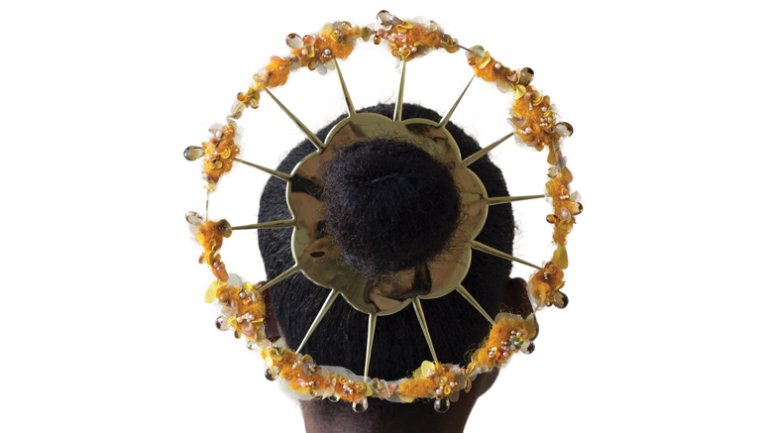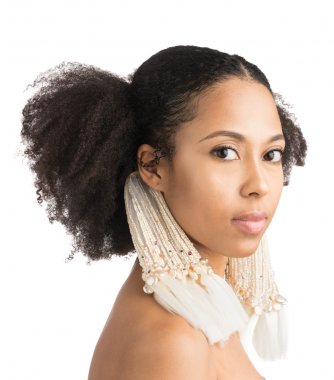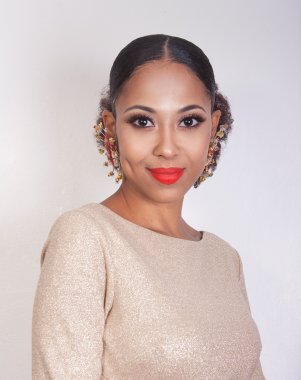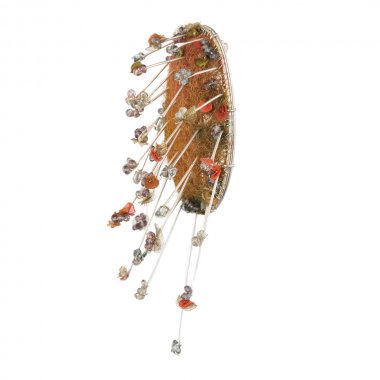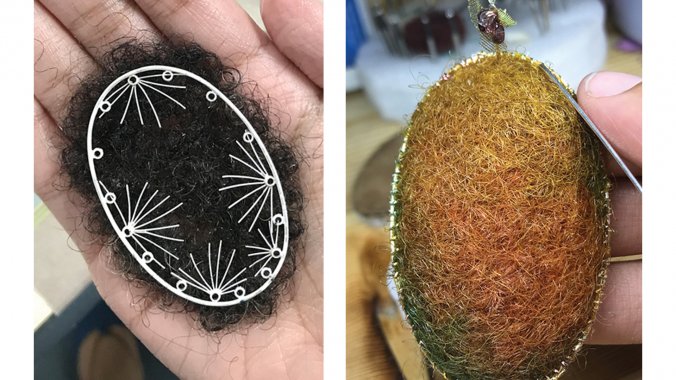Taisha Carrington
Taisha Carrington
At 14, Taisha Carrington first chemically relaxed her Afro. Like many of her black peers in her native Barbados, she says she had considered straight, smooth hair essential for a more attractive, professional appearance. A decade later, the emerging jewelry designer created a series of earrings and hair accessories that uncovered her complicated, often negative beliefs about her natural hair, and she began a journey of self-acceptance.
In the 2018 series, Woke in the Wake, she treats her own hair as a precious material, transforming it into a backdrop for pearls, peridots, and garnets. “The work is based on how we see ourselves as Afro-Caribbean or African-American people, whose self-value can be challenged a lot personally and from external sources,” says Carrington, 26, who splits her time between Albany, New York, and the Caribbean.
Carrington was inspired by traditional African hairstyles, such as the dramatic crownlike coif worn by Mangbetu women in the Democratic Republic of Congo. Yet for other elements – the sunburst shapes in gold-plated brass and silver, the intricate beadwork, the lace pattern etched onto a scalloped locket – “I was pulling from European royalty attire and jewelry,” she says.
Pairing bold African silhouettes with European details is key to Carrington’s approach. “Aesthetically, I married the two influences that formed Barbados, which was a British colony with West African descendants,” she says.
A golden, 8-inch-diameter halo designed to surround a hair knot is one standout from the collection. “I wanted something that wasn’t timid, wasn’t afraid to be present and demand attention,” Carrington says.
To transform human hair into a textile, the artist has adapted wet-felting techniques. When she washes her own hair, she runs her hand through it to collect any loose strands. Later, she forms them into a loose ball that’s about six times bigger than the desired final size, and places it in a shampoo and water bath. Carrington says the added moisture interlocks the fibers and shrinks the size of the ball. She then compacts it further by tossing it back and forth from one hand to the other. Finally, she bleaches the resulting fabric and applies hair dye in rich shades of ruby, turquoise, and topaz, before working it into her designs.
Carrington developed her aesthetic at Pratt Institute in Brooklyn, where in 2018 she earned a degree in jewelry design and won first prize for outstanding thesis collection. Though she did not realize it at the time, elevating her hair to the level of precious metals and stones began a process of healing. “I was trying to find a way to address conflicts that I was having with myself, conflicts I saw were reflected in many of the black women I knew,” Carrington says.
Although her intentions were personal, her jewelry sparkled with fresh relevance last summer when California became the first state to ban workplace and school grooming policies that disproportionately affect people of color, who often face discrimination for wearing hairstyles such as Afros, cornrows, and dreadlocks. “I didn’t set out to cover politically challenging subjects,” Carrington says, “but I’m also not afraid to take that on.”
Sense of Self
An early start: “I’ve never known myself to not do art,” Carrington says. When she was 3 years old, her nursery school teacher told her mother she was a maestra with crayons. “I made a conscious effort to color inside the lines.”
Showpiece: Carrington won first place in the Miss Barbados World pageant in 2011, thanks in part to her creativity in the talent category. She performed a contemporary dance on a large canvas while spreading pigment with her hands and feet. The routine “was choreographed so that when it ended, I had a painting, which was then lifted into the air,” she says.
Playing with scale: At Pratt Institute, Carrington was originally accepted into the architecture program. She decided to pursue sculpture instead, which she studied for two years before settling on jewelry design. “I started really big, and I was getting smaller and smaller. But I think my small still wasn’t very small,” she says with a laugh, referring to the scale of her earrings and hair accessories.
